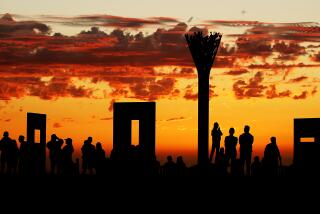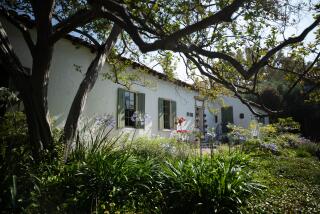Remember Alamo? Add Goliad
- Share via
GOLIAD, Tex. — The ragtag band of Texans attacking the Mexican army at San Jacinto shouted, “Remember the Alamo! Remember Goliad!”
In the years that followed, Alamo became a household word. Goliad, where there was twice as much loss of life, has almost been forgotten. Until now.
On a weekend to remember, you may discover that Goliad is one of Texas’ most unspoiled treasures.
The tiny town is laid out on brushy, live oak-covered hills across the San Antonio River from Presidio La Bahia, the fort where 352 Texas prisoners were massacred during the revolution.
The massive rubble stone walls of Presidio La Bahia command a hill overlooking the winding river.
Built in 1749, Goliad’s La Bahia is the oldest surviving fort west of the Mississippi. Inside the eerie silence of the 3 1/2-acre quadrangle, Texas’ first flag of independence from Mexico, a white banner emblazoned with a bloody arm defiantly holding a saber, flaps in the warm South Texas breeze.
After the fall of the Alamo, Gen. Sam Houston ordered volunteers at Goliad to join his army as it prepared to fight forces led by Santa Ana. When the men marched away from the fort, they were overtaken by Mexican troops.
After a long battle, and in the face of overwhelming odds, the Texans surrendered and were returned to Goliad.
Captives Gunned Down
A week later, the captives were marched about half a mile in three directions before they were gunned down. The wounded were shot within the walls. About 48 lived to tell the story.
Within the presidio’s walls, you’ll step past giant, hand-carved doors into the cool, dimly lit interior of Our Lady of Loreto Chapel. Plaster walls reach to the groin-vaulted ceiling, the only ceiling of its kind surviving from the Spanish Colonial period.
As you stand in the chapel, imagine all the prisoners confined for a week in this tiny room without windows. The scene must have stirred the heart of the heroine in this story, Senora Pachita Alvarez, a woman who claimed to be the wife of a Mexican captain. Remembered by survivors as the “Angel of Goliad,” she helped several young men escape, and begged for mercy for others.
During the 1960s restoration, the soldiers’ quarters were converted into a museum where archeological discoveries are displayed from nine levels of occupancy dating beyond the Spanish Colonial period to early Indian times.
In recent years, historians have been surprised to discover that La Bahia took an active part in the American Revolution. Spanish soldiers from Goliad fought the British in Baton Rouge, Natchez and Pensacola. Soldiers also drove cattle from the mission’s vast ranch to feed Spanish forces in Louisiana.
Limestone Monument
From a rear bastion in the quadrangle you can see across the grassy hilltop a limestone monument towering above a mass grave. Several months after the massacre, Gen. Thomas Rusk’s army gathered the scattered bones and buried them in the mass grave with full military honors. Names of the known dead are inscribed at the base of the tomb.
Across the river, the old fort’s charge, Mission Nuestra Senora del Espiritu Santo de Zuniga, rises gracefully from a hill covered in anaqua and live oak trees. You follow a winding walk past a low stone fence and up to huge double doors of the mission church.
Franciscan friars labored 110 years trying to Christianize the Indians and teach them cattle ranching, gardening, spinning, weaving and pottery making.
Although the mission boasted a cattle ranch of up to 40,000 head, which is claimed as the beginning of Texas’ cattle industry, the padres weren’t successful in civilizing the nomadic Indians.
You’ll walk through the old granary that serves as a museum depicting the history of the Indians, priests and soldiers. Beyond the grassy courtyard, the mission school workshop houses meager furnishings of the padres.
Throughout the year, park personnel conduct living-history demonstrations, such as weaving, soap making, pottery making and natural dyeing.
The mission church still hosts special events--a jazz mass in October and a cantata and candlelight mass in December. During Christmas season, luminarias (paper-bag lanterns) outline the graceful curves of the roof.
Goliad, the Anglo town that grew up around the presidio and mission, is canopied in giant live oaks that shade Victorian homes built with cattle wealth. Citizens are so fond of the massive oaks that streets have been paved around the stately trunks and trees still dominate the courthouse square.
Many of the 19th-Century buildings circling the square have been rehabilitated. Grand porches extend over the sidewalk, and handsome pressed metal cornices and fancy brick detailing highlight the beauty of century-old craftsmanship.
A general store built in 1903 has been converted into the Empresario, a combination gift shop, restaurant and bakery.
Up the the street, a weaver operates Just for Ewe, a shop where you can watch the weaver creating rugs, towels, place mats and clothing.
Nationally known artist Dalhart Windberg, a native of Goliad County, has opened a gallery in an old building known about town as the Wells Fargo office.
Across the street, the red frame Market House Museum displays unusual local artifacts such as equipment from an early broom factory, the 20-gallon, hand-cranked, ice cream freezer from Goliad’s first drugstore and a washboard made especially for silk hose.
It is a two-block stroll from downtown to the White House Inn, a bed and breakfast inn built in 1933 as the weekend home of a former Houston Chronicle editor. The handsome old house is shaded by a 100-year-old oak tree and circled by a white plank fence.
Huge Breakfasts
Three large rooms are handsomely furnished, and innkeepers Janice and Mert Rawson serve a huge breakfast in the antique-filled dining room.
Horse race fans descend on Goliad in February, March, July and September when La Bahia Downs, on the northern edge of town, holds quarter-horse races.
After a weekend in this community of 2,000, it will be hard not to “Remember Goliad!”
For group tours or more information about lodging and local events, contact Goliad County Chamber of Commerce in the Market House Museum, P.O. Box 606, Goliad, Tex. 77963, phone (512) 645-3563.
Rates at the White House Inn range from $35 double for two extra long single beds to $45 double for a king-size bed. Write to 203 N. Commercial, Goliad, Tex. 77963, or phone (512) 645-2701.
Plan a day trip 45 miles southeast to Aransas National Wildlife Refuge, winter home from October through March of giant whooping cranes and base for many other migratory birds and wildlife.
Goliad is about 75 miles southeast of San Antonio.
More to Read
Sign up for The Wild
We’ll help you find the best places to hike, bike and run, as well as the perfect silent spots for meditation and yoga.
You may occasionally receive promotional content from the Los Angeles Times.






